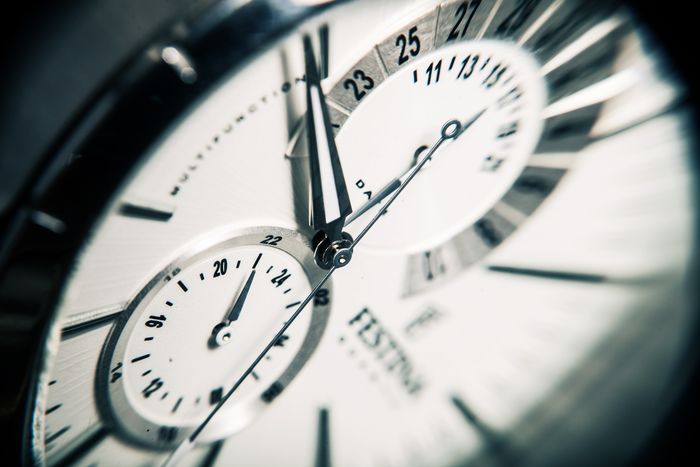| What time is it ? กี่โมง แล้ว ( ครับ / ค่ะ ) gèe mohng láew ( kráp / kâ ) |
The Thai way of telling the time takes a little getting used to, as it's very different from English and other European languages. Thais do use the familiar 24 hour military time system to some extent, for example for official announcements, but in every day life a different and uniquely Thai system is used instead. The easiest way to approach it is to recognise that the Thai clock is divided up into roughly 4 blocks of 6 hours each rather than 2 of 12, and that each of these blocks of time is referred to in a different way.
For telling time between the hours of 1am and 5am, the number of the hour is preceded by the word ตี dtee . This is also the verb "to strike", and its use here comes from the ancient custom of a night watchman striking a drum on the hour throughout the night to reassure village residents of their safety.
| 12am / Midnight
เที่ยงคืน tîang keun 1am ตีหนึ่ง dtee nèung 2am ตีสอง dtee sŏng 3am ตีสาม dtee săam 4am ตีสี่ dtee sèe 5am ตีห้า dtee hâa |
From 6am to 11am, the number of the hour is followed by the word โมง mohng ("o'clock") and optionally also เช้า cháo ("morning"). This is where you can see that the day is divided into 4 blocks, as the hours from 7am - 11am can also be referred to using the numbers 1 - 5 followed by โมง เช้า mohng cháo . 9am, for instance, can be either เก้าโมงเช้า gâo mohng cháo ("9 o'clock in the morning") or สามโมงเช้า săam mohng cháo ("3 o'clock in the morning").
6am can only be referred to as หกโมงเช้า hòk mohng cháo though, leading to the somewhat bizarre situation of hòk mohng cháo ("6 o'clock in the morning", 6am) actually being earlier in the day than, say, สองโมงเช้า sŏng mohng cháo ("2 o'clock in the morning", 8am).
| 6am
หกโมง (เช้า ) hòk mohng ( cháo ) 7am เจ็ดโมง (เช้า ) jèt mohng ( cháo ) / หนึ่งโมงเช้า nèung mohng cháo 8am แปดโมง (เช้า ) bpàet mohng ( cháo ) / สองโมงเช้า sŏng mohng cháo 9am เก้าโมง (เช้า ) gâo mohng ( cháo ) / สามโมงเช้า săam mohng cháo 10am สิบโมง (เช้า ) sìp mohng ( cháo ) / สี่โมงเช้า sèe mohng cháo 11am สิบเอ็ดโมง (เช้า ) sìp èt mohng ( cháo ) / ห้าโมงเช้า hâa mohng cháo |
The hours between 1pm and 6pm are referred to using the words บ่าย bàai ("early afternoon") and เย็น yen ("late afternoon/early evening"). 1-3pm are always referred to using bàai, 5-6pm using yen . 4pm is borderline between the two time periods and can be referred to using either of them, though it's more common to use yen.
| 12pm / Noon
เที่ยง tîang 1pm บ่ายโมง bàai mohng 2pm บ่ายสอง (โมง ) bàai sŏng ( mohng ) 3pm บ่ายสาม (โมง ) bàai săam ( mohng ) 4pm สี่โมงเย็น sèe mohng yen / บ่ายสี่ (โมง ) bàai sèe ( mohng ) 5pm ห้าโมงเย็น hâa mohng yen 6pm หกโมงเย็น hòk mohng yen |
If the context makes it clear that it's the afternoon not the morning being referred to, then the yen or bàai can be dropped to leave just the number of the hour followed by mohng.
The hours from 7pm to 11pm are referred to using the numbers 1 - 5 followed by the word ทุ่ม tûm.
| 7pm
หนึ่งทุ่ม nèung tûm / ทุ่มหนึ่ง tûm nèung 8pm สองทุ่ม sŏng tûm 9pm สามทุ่ม săam tûm 10pm สี่ทุ่ม sèe tûm 11pm ห้าทุ่ม hâa tûm |
Midnight is occasionally referred to as หกทุ่ม hòk tûm , but much more common is เที่ยงคืน tîang keun as above.
The number of minutes past the hour are then added on. Thai has no equivalent to the English "quarter to" and "quarter past" (the numbers 15 and 45 are used instead), but for "half past" the word ครึ่ง krêung ("half") can be used.
| What time is it ?
กี่โมง แล้ว ( ครับ / ค่ะ
) gèe mohng láew ( kráp / kâ ) What time does the bus leave ? รถ จะ ออก กี่โมง ( ครับ / ค่ะ ) rót jà òk gèe mohng ( kráp / kâ ) What time do you close ? ที่นี่ ปิด กี่โมง ( ครับ / ค่ะ ) têe nêe bpìt gèe mohng ( kráp / kâ )
7.15am
เจ็ดโมง (เช้า )สิบห้า
jèt mohng ( cháo ) sìp hâa
3.20pm
บ่ายสาม ยี่สิบ bàai săam yêe sìp
8.30pm
สองทุ่ม ครึ่ง sŏng tûm krêung
5.50am
ตีห้า ห้าสิบ dtee hâa hâa sìp |









Comments